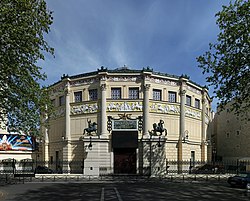TheCirque d'Hiver( "Winter Circus" ), located at 110 rue Amelot (at the juncture of the rue des Filles du Calvaire and rue Amelot,Paris11ème), has been a prominent venue forcircuses,exhibitions ofdressage,musical concerts, and other events, including exhibitions ofTurkish wrestlingand even fashion shows. The theatre was designed by the architectJacques Ignace Hittorffand was opened byEmperor Napoleon IIIon 11 December 1852 as theCirque Napoléon.The orchestral concerts ofJules Etienne Pasdeloupwere inaugurated at the Cirque Napoléon on 27 October 1861 and continued for more than twenty years. The theatre was renamed Cirque d'Hiver in 1870.[1]
| Cirque d'Hiver | |
|---|---|
 The Cirque d'Hiver in 2011 | |
| Former names | Cirque Napoléon, Cirque National |
| Alternative names | Cirque d'Hiver-Bouglione |
| General information | |
| Type | Auditorium |
| Address | 110 Rue Amelot |
| Town or city | Paris |
| Country | France |
| Coordinates | 48°51′48″N2°22′03″E/ 48.86337°N 2.36753°E |
| Construction started | 17 April 1852 |
| Inaugurated | 11 December 1852 |
| Dimensions | |
| Diameter | 42 metres (138 ft) |
| Design and construction | |
| Architect(s) | Jacques Ignace Hittorff |
| Other information | |
| Seating capacity | 2090 |
| Website | |
| http:// cirquedhiver / | |
The nearest métro station isFilles du Calvaire.
History
editThe circus is an oval polygon of 20 sides, withCorinthian columnsat the angles, giving the impression of an oval building enclosing the oval ring, surrounded by steeply banked seating for spectators, very much like a miniature indoorColosseum.A low angled roof is self-supporting like a lowdome,so that there is no central pole, as under a tent, to obstruct views or interfere with the action.
The building was designed by the architectJacques Ignace Hittorffand opened as the Cirque Napoléon, a compliment to the new Emperor of the FrenchNapoleon III.The sculptorJames Pradierwas called upon to provide exteriorbas-reliefsofAmazons,and Francisque Duret and Astyanax-Scévola Bosio sculpted the panels of mounted warriors.[2]The guiding entrepreneur was Louis Dejean, the proprietor of the Cirque d'Été ( "Summer Circus" ) erected annually in thebosquetsthat flanked theChamps-Élysées.[3]Dejean wagered that evening circus performances under the limelight, with the spectators well removed from the dust and smells of the tanbark floor, would provide a dress occasion forle tout-Paris,and he was well rewarded for his acumen.
At the end of theSecond Empire,the Cirque d'Hiver was renamed the Cirque National, and was administered by Victor Franconi. It was given its present name in 1873.Henri de Toulouse-Lautrecrepeatedly found inspiration in rehearsals and performances at the Cirque d'Hiver;Georges Seuratpainted an afternoon performance, with a distinctly middle-class audience, inThe Circus,one of the greatest unfinished canvases in the history of Western painting (1890–91,Musée d'Orsay). Franconi's son Charles assumed direction, 1897–1907. Since 1934 it has been the Cirque d'Hiver-Bouglione, operated by the Bouglione brothers and their heirs. The original configuration accommodated 4,000, which has now been reduced to 2,090 due to fire codes.
The Cirque d'hiver was the site of the organization meeting of theAmerican Legionfrom March 15 to 17, 1919. The American Legion was originally founded as an organization for American veterans of the First World War and has since expanded its membership to include veterans of subsequent conflicts. It is the largest veterans organization in the United States.
At the Cirque d'Hiver in August 1955,Richard Avedontook his famous photograph of the fashion model "Dovimawith the Elephants "[4]to show a floor-length evening dress byDior,one of the most iconic fashion photographs of the century. In 1995, Parisian designerThierry Muglerheld a special fashion show at the circus, to celebrate his firm's 20th anniversary. Performers and special guests includedJames Brown,Tippi Hedrenand many of the decade's top supermodels, includingNaomi Campbell.British designerKatharine Hamnettalso chose the venue for some of her typically exuberant catwalk presentations.
Cirque d'Hiver in fiction
edit- In 1956Carol Reeddirected the filmTrapeze.It was in part filmed at the Cirque d'hiver.[5]
- Elizabeth Bishopwrote a poem titled "Cirque D'Hiver".[6]
See also
edit- List of works by James PradierHorsed Amazon sculpture
- Clown Bar,clown-themed bar two doors away, frequented by performers[7]
Notes
edit- ^Simeone 2000, p. 176
- ^Astyanax-Scévola Bosio (1793-1876) trained as a sculptor in the studio of his uncleFrançois Joseph Bosio.
- ^The grand-daughter of Dejean, Alice (Berlin 1852 - Paris 1901) would marryEmmanuel Chabrierin 1873. Delage, Roger.Emmanuel Chabrier.Paris, Fayard, 1999, p. 167.
- ^"Dovima with the Elephants"at theVictoria and Albert Museumwebsite. Accessed 30 July 2012.
- ^Stafford, Jeff."Trapeze".Turner Classic Movies (tcm ).Retrieved2008-12-29.
- ^Google books source
- ^Didier, Cyrielle."Le Clown Bar, antre historique des saltimbanques parisiens"[The Clown Bar, historic lair of Parisian acrobats].Zig Zag Paris(in French).Retrieved13 October2022.
Sources
edit- Simeone, Nigel (2000).Paris: A Musical Gazetteer.New Haven: Yale University Press.ISBN978-0-300-08053-7.
